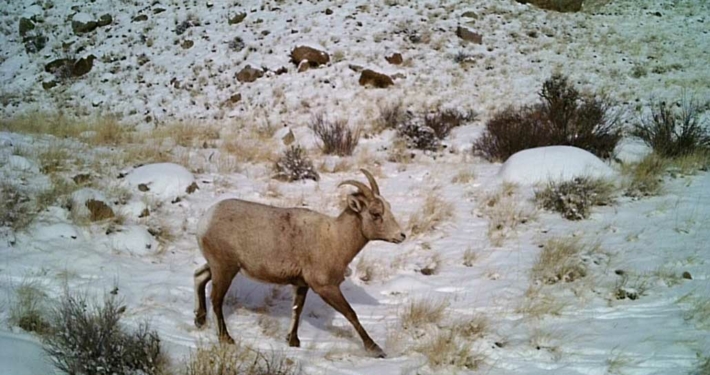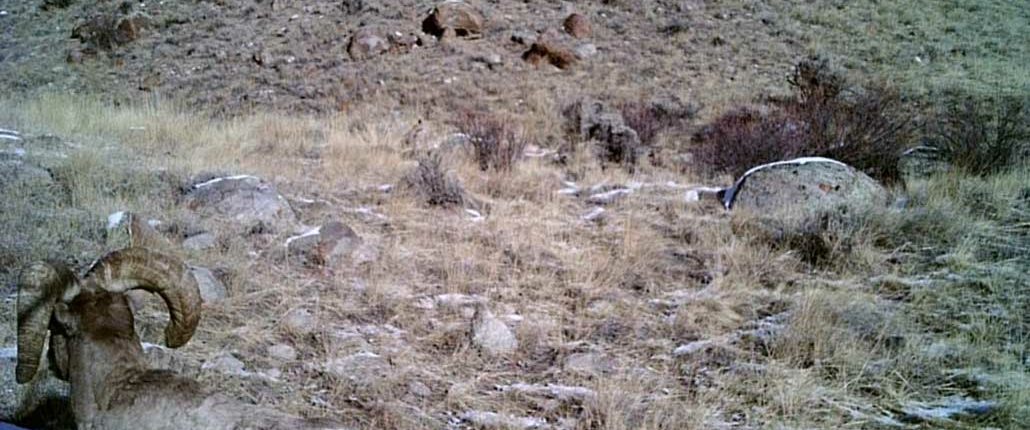Welcome to the Whiskey Basin Trail Camera Page!
These trail cameras help you examine the lifestyles of bighorn sheep and other wildlife in the absence of human interference. Current photos will be updated when new photos become available, so we invite you to check back often!
These photos were captured in March 2021. A light-colored ewe passes on a wintry day. The Whiskey Mountain area received a little snow earlier in the week, and this weather will push the sheep from higher grazing grounds to lower areas with less snow. Much snow has melted since the storm, and this melting will likely lead the sheep back up to Torrey Rim and other locations sheep prefer.

Bighorns’ teeth continue to grow throughout their lives! Their teeth wear down as they graze, lessening the likelihood of tooth decay.
 A 300-pound ram can drink 7.5 gallons of water at one time! The ram pictured to your right doesn’t weigh 300 pounds, but imagine yourself drinking even half that amount of water at once!
A 300-pound ram can drink 7.5 gallons of water at one time! The ram pictured to your right doesn’t weigh 300 pounds, but imagine yourself drinking even half that amount of water at once!
These photos were captured on 24-25 February 2021. These sheep are grazing and enjoying the sunshine.
These photos were captured on 14 February 2021. Lambs and ewes are passing by.
Please note their different colors, horn sizes, and other characteristics.

Thermal neutrality for bighorn sheep is 10°F! This state means bighorn sheep don’t have to exert any energy to stay warm or cool off in 10°F weather.
 Around 47,000 bighorn sheep live in the roughest parts of 13 western states and 2 Canadian provinces. Named for their massive, curling horns (which can grow to 50 inches in length), the iconic “Ovis Canadensis” are known for their agility and near-perfect balance.
Around 47,000 bighorn sheep live in the roughest parts of 13 western states and 2 Canadian provinces. Named for their massive, curling horns (which can grow to 50 inches in length), the iconic “Ovis Canadensis” are known for their agility and near-perfect balance.
These photos were captured on 12 February 2021. Pictured are a ram and a collared ewe.
The ram passes first in search of food. The collared ewe passes by later, after the ram–these sheep likely spent most of their evening in this vicinity. The radio collar on the ewe uploads data, including locations, to software programs that help biologists chart seasonal migration, areas of habitat use, population estimates, and other bighorn activities. Collars are vital for on-the-ground data collection.
These photos were captured on 30 January 2021.
Trail cameras capture only what they see directly in front of them. They capture only glimpses into this ecosystem. Our imaginations help us suppose the bigger picture–were other rams or ewes present? Did a mountain lion pass behind the trail camera?
 Rocky Mountain Bighorn rams’ horns average around 30-35 pounds! Ewes’ horns are much smaller and possess less curvature. Both rams (males) and ewes (females) will keep their horns for life. In this way, horns are different from antlers–antlers, like those of deer and elk, are shed each year. Horns, on the other hand, continue to grow in length year after year. In bighorns, this lifelong horn growth is most noticeable in rams. Bighorn sheep horns are made of keratin, the same material our fingernails are made of!
Rocky Mountain Bighorn rams’ horns average around 30-35 pounds! Ewes’ horns are much smaller and possess less curvature. Both rams (males) and ewes (females) will keep their horns for life. In this way, horns are different from antlers–antlers, like those of deer and elk, are shed each year. Horns, on the other hand, continue to grow in length year after year. In bighorns, this lifelong horn growth is most noticeable in rams. Bighorn sheep horns are made of keratin, the same material our fingernails are made of!
 Bighorn sheep have terrific eyesight that allows them to see any potential threats approaching from a distance. Bighorn sheep have a field of view of 320-340 degrees. To put bighorns’ eyesight into perspective, a human would need 7-power binoculars to match a bighorn’s viewing distance!
Bighorn sheep have terrific eyesight that allows them to see any potential threats approaching from a distance. Bighorn sheep have a field of view of 320-340 degrees. To put bighorns’ eyesight into perspective, a human would need 7-power binoculars to match a bighorn’s viewing distance!
These photos were captured on 1 January 2022. Happy New Year!
This ram wanders through sage brush.
These photos were captured on 1 January 2021. These ewes are on the move.
These two ewes passed our camera about an hour after the young ram passed.
 Bighorn sheep share habitats with many other wildlife species. During winter months, bighorns will live alongside other prey species such as mule deer and elk. Once summer comes and snow recedes to higher elevations, these prey species spread out to higher elevations. Throughout the year, predators (including mountain lions, wolves, coyotes, and bobcats) will travel to follow these prey species. Mountain lions are common predators of adult bighorn sheep, and, perhaps unexpectedly, predators such as golden eagles will prey on bighorn lambs!
Bighorn sheep share habitats with many other wildlife species. During winter months, bighorns will live alongside other prey species such as mule deer and elk. Once summer comes and snow recedes to higher elevations, these prey species spread out to higher elevations. Throughout the year, predators (including mountain lions, wolves, coyotes, and bobcats) will travel to follow these prey species. Mountain lions are common predators of adult bighorn sheep, and, perhaps unexpectedly, predators such as golden eagles will prey on bighorn lambs!
















